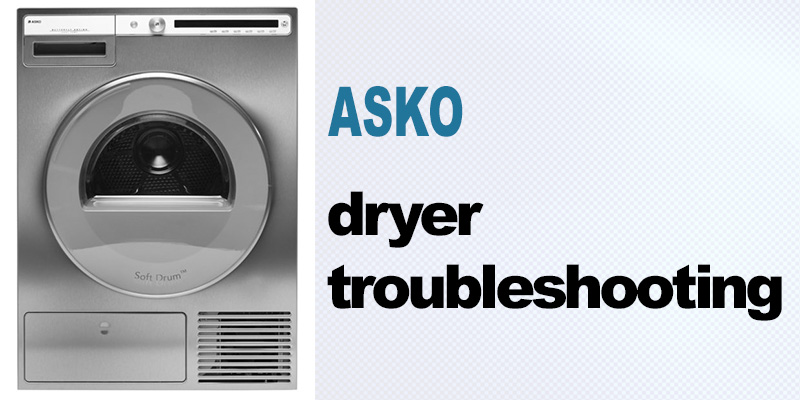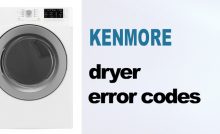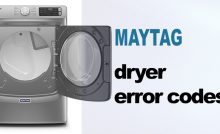



In case your Asko dryer has an issue or won’t work at all, calling a technician may seem like the most natural thing to do. And yet, it makes sense to take a look at the troubleshooting tips below and try the suggested solutions – there’s every chance you’ll fix the appliance on your own.
These instructions were developed by engineers from the Asko Appliances AB. The company, also known under the name of Asko Cylinda, is a Swedish white goods manufacturer founded in 1950 by Karl-Erik Andersson.
Asko DC7171 dryer troubleshooting
| Problem | Cause | Corrective action |
|---|---|---|
| Garments are not being dried as expected. | The house breaker for drying cabinet has tripped. | Check. |
| Cycle control and/or time switch has not been correctly set. | Check the setting. | |
| The drying cabinet is being used in a room with a temperature lower than 0°C (32°F). | Normal operation requires installation in a room with a temperature over 0°C (32°F). | |
| Poorly spun-dried items or too much remaining moisture in the garments. | If the clothing is too wet, use a higher spin speed on the washing machine. | |
| Have the time and temperature knobs been for too little time or a temperature too low? | Increase the program length and temperature to achieve the desired level of dryness. | |
| Is the vent pipe/hose too long? | Length should not exceed 39 inches (1 m). | |
| The drying cabinet does not produce enough heat even thought the cycle control is activated. | Is the power plug inserted? | Check. |
| Is the drying cabinet door closed? | Push firmly on the door to make sure it is closed. | |
| Was the “START” button fully depressed? | Press the button again. | |
| Has the time switch been set? | Check. | |
| The overheating protector has tripped. | Turn the time switch back to “0” and wait 30 minutes. After 30 minutes has passed, turn the time switch to 30 minutes and press the “Start” button. | |
| The overheating protector is faulty. | Contact our Customer Care Center. |
Asko T701 dryer troubleshooting
| Problem | Cause/Solution |
|---|---|
| The machine won’t start. | Make sure the door is closed securely. Make sure the Power is turned on. Check that you set the program or time correctly. Check that the electric plug is securely in the socket. Check the house breaker/fuses and the fuses on the back of the dryer. If all of the above options are eliminated, the overheat protection has probably been activated. |
| The machine starts but it stops when I release the power button. | The overheating protection has probably activated. Clean the lint filter and let the machine cool down before trying again. |
| The machine takes too long to dry my laundry. | Check that the lint filter is clean. If you use dryer sheets (not recommended), you may need to wash the lint filter with warm water and a soft brush to clean any blocked holes. Be careful not to overload the dryer because the warm air needs sufficient room to circulate properly and the clothes need room to tumble freely. The laundry should only be damp when it comes out of the washer. If it seems too wet, try using a faster or longer spin cycle. Make sure the outside vent exhaust is not blocked. |
| My clothes are coming out wrinkled. | You should remove the clothes as soon as the dryer signals the end of the cycle. If you can’t remove the clothes right away, use the Anti-crease option. Dry heavy fabrics together and light fabrics together. Dry only permanent press items together. Dry in smaller loads. Use slower spin speeds. Use fabric softener in the rinse program. You may be using the wrong wash temperature. Try using a lower wash temperature, especially for permanent press and delicate items. |
| The motor is running but the drum isn’t turning. | This usually means a belt is broken. Call a servicer. |
| The machine makes a funny noise. | A slight rumbling may be heard when you first turn on the dryer. This is normal and it should only last a few seconds. |
Asko T741 dryer troubleshooting
| Display shows | Explanation | Proposed measure |
|---|---|---|
| F1 | This means that the condensation water container is full. If the condensation water is pumped out directly via the drain hose, check that the hose is free from kinks or blockages. If this does not help, call service. | Empty the condensation water container and restart. If the fault message appears again, this may mean that the lower water reservoir is full because the pump or the hoses are blocked or worn. |
| F2 | Maximum program time | The machine stops after it has operated for the max- imum period (3 hours). Check and replace any blown fuses in the electrical distribution box for the building. To exit from the fault message, switch off the machine or open the door. If this does not help, call service. |
| F2 | Thermistor fault | Call service. |
| F4 | Thermal protection (Not fitted to all machines.) | Clean the filter and the condenser. |
| F5 | Sensor fault | Fault in the moisture sensor. This fault message can also be displayed if you are already operating with dry clothes or an empty machine. The message should disappear if you open the door. If not, call service. |
Asko TD25 dryer troubleshooting
| Fault symptom | Cause | Action |
|---|---|---|
| The machine will not start. | The outer door is not properly closed. | • Check that the door pin is activating the door switch. |
| The machine is not supplied with power. | • Check the fuses and connections. | |
| The machine stops. | The automatic overheating protection has tripped. | Check if the customer has: • Opened the door and cleaned the filter and condenser unit • Left the door open long enough for the overhea- ting protection to be reset and the display and LEDs to light up • Attempted to restart the programme Service action: • Clean internal fan wheel, condenser, air ducts and element. • Check the seals. |
| The overheat protection in the motor has been tripped. | • Clean and check the motor. • If necessary, replace the motor. | |
| Defective control unit | • Replace control unit. | |
| The washing does not get dry. | Air leakage at the door seals is affecting the drying results. | • Check the sealing strips. |
| Air leakage around the motor shaft affects the drying result | • Check the seal around the motor shaft. | |
| Defective rear thermistor | • Replace the thermistor. | |
| Defective control unit | • Replace control unit. | |
| Drying is uneven. | Mixing of various types of items can lead to une- ven drying results. | Customer information: • Check that different types of items are not mixed in the same machine. Remove the dry items. |
| How full the machine is affects the drying results. | Customer information: • Check that the machine is not overfilled. Re- move some of the washing if necessary. | |
| Tumble-drying takes too long. | The lint filter is blocked | Customer information: • Cleaning the lint filter. |
| The condenser unit is blocked. | Customer information: • Clean the condenser. | |
| The washing machine's spinning affects drying. | Customer information: • Spin at a minimum of 800 rpm. | |
| The machine is in a room with poor ventilation. | Customer information: • Open doors to adjacent rooms. | |
| The evacuation hose is too long, blocked or bent. | Customer information: • Try to make the hose length as short as pos- sible with as gentle bends as possible. |
Asko TD70.C dryer troubleshooting
| Display | Cause | Action |
|---|---|---|
| Over flow fault. | The microswitch is opened when a full condensed water tank is detected. Detection begins 30 seconds after the programme starts. If the microswitch is open >30 seconds the programme cycle is stopped. | Check whether the customer has: • Emptied the tank and restarted the machine. Service action: • Clean hoses and check voltage and resistance of drainage pump. • Check that the float has not got "stuck" and check the function of the microswitch. |
| Max Program Time. | The programme cycle time exceeds 200 minutes. The cycle is stopped and the programme is reset. High ambient temperature combined with low heater output and low drying temperature leads to poor condensation formation. Poor condensation due to blocked external air | Check whether the customer has: • Tried spinning at a higher speed. • Had the machine switched off for 30 minutes before restarting. • Good ventilation in the room. Service action: • Ensure that the external air has free passage. |
| Thermistor fault. | 1. Thermistor circuit open 2. Thermistor malfunction | Service action: Check the thermistor. Replace if necessary. |
| Clean condenser. | 1. Displayed according to the interval set in the service menu. | Check whether the customer has: • Cleaned the condenser and the filter. • Cleaned the other air passages. |
| Clean Lint filter. | 1. Displayed according to the interval set in the service menu. | Check whether the customer has: • Cleaned the lint filter. |
| Clean auto filter. | 1. Displayed according to the interval set in the service menu. | Check whether the customer has: • Cleaned the water filter. |
| Clean filter. | 1. Displayed according to the interval set in the service menu. | Check whether the customer has: • Cleaned the evaporator filter and the evaporator. |
Asko TL751 XXL dryer troubleshooting
| Question | What to Do |
|---|---|
| • Is the dryer plugged in? | Confirm that the dryer's plug is securely and completely pushed into the laundry room's power outlet. |
| • Is the fuse blown, or is the circuit breaker tripped? | Check your home's or laundry room’s fuse box/circuit breaker box and replace the fuse or reset the circuit breaker. (IMPORTANT: electric dryers generally use two fuses or breakers.) |
| • Is the fuse blown, or is the circuit breaker tripped? | If the fuse is blown or the circuit breaker tripped, the dryer might tumble but not heat. Check your home’s or laundry room's fuse box/circuit breaker box and replace the fuse or reset the circuit breaker. (IMPORTANT: electric dryers generally use two fuses or breakers.) |
| • Is the gas supply or service blocked or off? | Confirm that the house gas shutoff and the dryer gas shutoff are both fully open. |
| • Did you follow the instructions on your fabric softener product? | Confirm and follow the instructions provided with your fabric softener product. |
| • Are you drying dean and dirty clothes together? | Make sure to use your dryer to dry only clean items, because dirty items can soil clean clothes placed in the same load or later placed in the dryer drum. |
| • Were your clothes entirely clean? | Stains on dried clothes are actually stains that weren’t cleansed during the washing process. Please review and confirm that you are following your washing instructions and that the clothes are being completely cleaned. |
| H1 | Humidity sensor error. Power off and restart. |
| H2 | Temperature sensor error. Power off and restart |
| H5 | Heater temperature control problem. Call our customer care center. |
| H3(GAS TYPE) | Rame detector problem. Call our customer care center. |
| H7(GAS TYPE) | Gas valve or gas valve blockage problem. Check your gas supply at the connection of gas hoses and valves. |
| H8(GAS TYPE) | Igniter and flame detector problem. Call our customer care center. |
| • Is your lint filter full? | Please confirm that the lint filter is clean. It is important that the lint filter is clean before each new load of laundry. |
| • Did you properly sort your load of laundry? | In order to reduce the amount of lint in a load of laundry, sort Bnt producers (like a fuzzy white cotton towel) separately from clothes that might catch lint (such as a pair of black linen pants). |
| • Did you overload your dryer? | Divide your larger load into smaller loads. |
| • Did you place any paper, tissue, or other similar material in the load? | Sometimes a person might forget to take a piece of paper or a tissue out of a pocket, and this paper, tissue, or similar material can cause excess lint in a load of laundry. |
| Confirm that the pockets of pants, shirts, and other articles of clothing are empty before washing and drying. | |
| • Did you use fabric softener? | Try using a fabric softener to reduce static electricity. |
| • Did you over dry the load of laundry? | Over-drying a load of laundry can cause a build up of static electricity. Try using a fabric softener or adjust your settings and use a shorter drying time. |
| • Are you drying synthetic, permanent press and blends? | These materials can cause static to build up in a load of dried clothes. Try using a fabric softener. |
| • Are you using consistent heat settings and consistent load sizes? | The drying time for a load will vary depending on the heat setting, the type of heat used (electric, natural or LP gas), the size of the load, the type of fabrics, the moisture of the clothes and the condition of the exhaust ducts and lint filter. |
| • Is water found around cabinet cover when opening the door? | This is normal because this is condensed moisture by drying. |
| • Did you properly sort your loads of laundry? | Separate heavy weight items from light weight items when creating loads. |
| • Are you drying large loads of heavy fabrics? | Heavy fabrics take longer to dry because they tend to retain more moisture. To help reduce and maintain more consistent drying times for large and heavy fabrics, separate these items into smaller loads of a consistent size. |
| • Are the dryer controls properly set? | Use the appropriate control settings for the type of load you are drying. |
| • Is the lint filter clean before each new load of laundry? | Please confirm that the lint filter is clean prior to each new load of laundry. |
| • Are the exhaust ducts clear and properly configured? | Venting duct work is properly not configured. Confirm that the venting is free of obstructions. Confirm that the outside wall dampers are moving freely, that the dampers are not pushed in, and that nothing has been set against the dampers. |
| • Is the fuse blown, or is the circuit breaker tripped? | Check your home’s or laundry room’s fuse box/circuit breaker box and replace the fuse or reset the circuit breaker. (IMPORTANT: electric dryers generally use two fuses or breakers.) |
| • Did you overload your dryer? | Divide your larger load into a number of smaller loads. |
| • Did you under load your dryer? | If you are only drying a handful of items, add a few extra pieces to help ensure proper tumbling action. |
| • Are you over drying your laundry? | Over drying a load of laundry can lead to wrinkled clothes. Try a shorter drying time, and remove items while they still retain a slight amount of moisture. |
| • Are you removing your laundry from the dryer soon after the drying cycle is complete? | Remove your laundry from the dryer after the drying cyde ends and either hang or fold the items. |
| • Are you following the care instructions for your garment? | To avoid shrinkage, please carefully follow the care and use instructions for your garment, because some fabrics will naturally shrink when washed. Other fabrics can be washed but will shrink when dried in a dryer. |
Asko TL751 XXLW dryer troubleshooting
| Trouble | Symptom | Cause | Solution |
|---|---|---|---|
| Power | Main power lead problem | A fault of Lead-in wire power | Call the electricity provider or an expert |
| Fuse disconnection of service wire | |||
| Dryer wiring problem | Disconnection of the power cable (Connection fault) | Replace the power cable | |
| Disconnection of a controller terminal pin and connector | Plug in the connector | ||
| ConnectiorYterminal contact fault of a terminal block | Connect the wire | ||
| Electric parts problem | Fuse disconnection | Replace the fuse | |
| Voltage problem | Rating for electric type: 120V/240V | Check the rating | |
| PCB problem | Pin connect contact fault | ||
| Circuit fault | Replace PCB | ||
| S/W fault of Panel F | Replace Panel F PCB | ||
| Microcomputer error | Replace PCB | ||
| Broken plate | |||
| Harness disconnection | Replace/Connect Harness | ||
| Noise | Noise at the initial operation | Installation | Place the unit on the flat ground |
| Impurities in the drum | Remove the impurities | ||
| Noise during the operation | Impurities on the fan | Disassemble the init and remove the impurities | |
| Loosened fan | Tighten the fan | ||
| Excessive laundry | Reduce the laundry | ||
| Impurities between the drum and SUP F,R | Remove the impurities | ||
| Friction of the belt | Replace the belt |
Recent Posts
Speed Queen washer error code fl
A leak error. To fix a leak, do the following: Locate damaged hoses and replace…
Speed Queen error code nf
To fix the error, you can try the following steps: Make sure the hoses are…
Bosch dishwasher e23 error
When it comes to reliable home appliances, Bosch is a brand that quickly comes to…
Bosch dishwasher e17 error
The Bosch dishwasher, a renowned name in the realm of kitchen appliances, has earned its…
Samsung dishwasher f3 error
Understanding the complexities of modern appliances like the Samsung dishwasher can be a daunting task.…
Samsung dishwasher error code f5
Kitchen appliances such as dishwashers are vital tools that help make our lives easier. Among…


